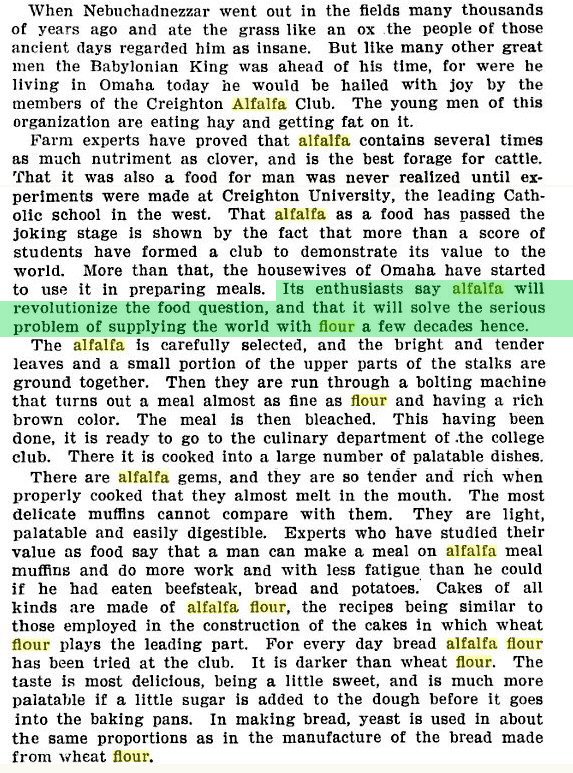Sunday, July 15, 2012
Why not take the short road?
Bill Gates is putting lots of money into genetic research to develop 'legume-like' varieties of wheat and corn, capable of using soil bacteria to obtain their own nitrogen. He wants to make farming easier in places that can't afford fertilizer, and also to eliminate the toxic runoff from fertilizer.
Why bother to make 'legume-like' wheat when you can simply get flour from actual legumes?
From a 1912 book, Alfalfa Farming in America:

I had to look up gems. They're apparently a type of cookie still popular in Britain:

= = = = =
Bit later: A BBC feature reports that some African farmers have solved the problem on their own. They plant corn along with various legumes, or rotate corn and legumes. Obviously gives less corn in the short run, but less fertilizer means more net income to the farmer in the long run. If the legume crop is a salable food like chickpeas, it will also give income.
= = = = =
And still later: A different periodical from around 1912 claims that the story about Creighton University was a hoax. After a century it's hard to tell which is right; the debunk was clearly written by wheat and corn men, and protesteth too much about all alternatives to wheat and corn.
Why bother to make 'legume-like' wheat when you can simply get flour from actual legumes?
From a 1912 book, Alfalfa Farming in America:

I had to look up gems. They're apparently a type of cookie still popular in Britain:
It's 1850 and in the town of Reading, Berkshire, emerging biscuit giant Huntley and Palmer is experimenting with some new biscuit technology. However, the new biscuits emerge from the oven having actually shrunken. Thomas Huntley likes the resulting mini biscuits which are christened Gems and they sell well. Sixty years later in 1910 they added icing and children's birthday parties would be incomplete without these mini biscuits from then on.It's clear from modern sources that alfalfa has more nutrition than corn or wheat. The alfalfa 'flour' uses more of the plant than just the seeds, thus leaving less wastage. Wonder why it never became popular?

= = = = =
Bit later: A BBC feature reports that some African farmers have solved the problem on their own. They plant corn along with various legumes, or rotate corn and legumes. Obviously gives less corn in the short run, but less fertilizer means more net income to the farmer in the long run. If the legume crop is a salable food like chickpeas, it will also give income.
= = = = =
And still later: A different periodical from around 1912 claims that the story about Creighton University was a hoax. After a century it's hard to tell which is right; the debunk was clearly written by wheat and corn men, and protesteth too much about all alternatives to wheat and corn.
Labels: 20th century Dark Age, Smarty-plants
